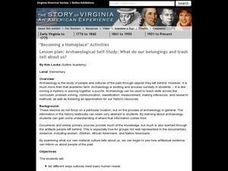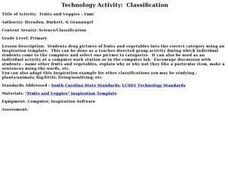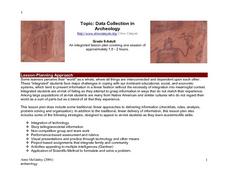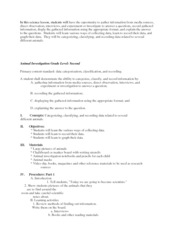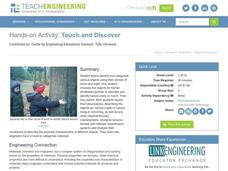Curated OER
Archaeological Self-Study: What Do Our Belongings and Trash Tell About Us?
Students examine how their belongings and their trash represents who they are. In this archaeology skills activity, students watch a video titled "Discovering the Past" and then give archaeological techniques a try. Students examine and...
Curated OER
Crime School Investigations
Students solve a mystery at their school. In this classifying lesson, students find suspects who committed the crime. Students categorize them into race, sex, and fingerprint type. Students show their results in graphs.
Curated OER
Ocean Market
Young scholars identify some consumer goods that come from the ocean.
They classify these items into groups, identify their source, and calculate the cost of buying such goods.
Curated OER
Explore: 1st Grade Plant Observation
First graders grow seeds in a mini terrarium. They compare the root systems, stems, leaves, and flowers of the different plants. They categorize the plants and discuss the basic functions of plant parts.
Curated OER
Pest Populations: A Game of Survival
Young scholars identify and classify populations of pests in the home, school and community. They recognize the specific conditions needed for the survival of an organism considered a pest and list tactics for control measures.
Curated OER
A Balanced Diet
High schoolers determine which healthy foods comprise a well balanced meal. Using a checklist, students classify foods as healthy or unhealthy. This lesson is intended for high schoolers acquiring English.
Curated OER
Fruits and Veggies - Yum!
Students use Inspiration to drag pictures of fruits and vegetables into the correct category. They discuss the name of other fruits and vegetables. They explain why or why not they like that particular fruit or vegetable. Students...
Curated OER
Classification
In this classification worksheet, students observe the fingerprints provided. Students decide upon a classification system to use to categorize the given fingerprints.
Curated OER
Four Sectors
Students explore the sectors of civil society. In this philanthropy lesson, students explore and categorize government, market, nonprofit, and household sectors.
Curated OER
Diversity Ecosystems
Young scholars work in teams to characterize their biomes and compare them to the biomes of the rest of the class. In this biomes lesson plan, students complete a bean activity, relate it to the diversity in biomes, and then research and...
Curated OER
Scavenging the Sandy Shore
Students explore oceanography by examining a beach. In this living things instructional activity, students define the terms abiotic and biotic and practice identifying living and non-living things that have been previously found on a...
Curated OER
Early Childhood Nutrition
Students complete activities that focus on food and nutrition. In this food lesson plan, students sort foods into healthy and not healthy, categorize them into ground and tree sorts, draw their favorite foods, make abc books of food, and...
Curated OER
Sorting Into Two Groups
Here is a way for your charges to sort pictures of children into 2 groups and put a title for each group. In this classification lesson plan, learners explain why they chose to separate the children the way they did.
Curated OER
Data Collection in Archaeology
Pupils research different types of rock art and categorize it into basic groups, classify Powerpoint Images according to interpretation, enter findings into Access template, and interpret results after comparing information with rest of...
Curated OER
Grouping Fruits and Vegetable
Students identify the differences between fruits and vegetables. In this nutrition lesson, students identify the properties of fruits and vegetables and group various fruits and vegetables into categories.
Curated OER
Understanding Science Vocabulary And Categorization
Pupils explore and examine scientific language and categorization as related to commonly known plants and animals. They hypothesize about a specific plant or animal, how it was scientifically named, what concepts and vocabulary is...
Curated OER
Tree-Mendous!
Pupils classify trees. In this tree-mendous lesson, students categorize a variety of trees to assist them in playing a Jeopardy like game. Pupils identify new vocabulary terms and classify the uses and benefits of trees for humans.
Curated OER
Animal Investigation
Third graders gather information and classify animals. In this animal investigation lesson, 3rd graders research animals, and organize the information into notebook.
Curated OER
This Place is Going to the Dogs
Students study different breeds of dogs. They watch a video, "Extraordinary Dogs", about special dogs and how they are categorized according to their adaptations. Then they create a digital video that demonstrates the qualities of dogs...
Curated OER
Touch and Discover
Students work together to identify and categorize objects. They have to identify the object on touch because they are blindfolded. They record their data and describe the objects once they can look at them.
Curated OER
Tag It and Bag It: Archeology Lab Lesson
Seventh graders practice analyzing, collecting and categorizing artifacts. Using charts, they organize and interpret information about the artifacts they classified. They work together to create a graph to represent class totals and...
Curated OER
Ima's Dream
Students compile a list of items on which a person can spend money, categorize a list of items based upon similarities, and solve mathematical problems based upon given scenarios.
Curated OER
Plant Growth and Environment
Third graders bring to school various green plants and categorize them into plant leaves, stems, roots, and fruits. They answer the question, "How can you show there is starch in a plant?" and perform the iodine test and describe the...
Curated OER
Soil Comparison and Analysis
Students perform tests on different soil samples. In this earth science lesson, students classify the soil into groups according to test results. They write a lab report following a certain criteria.


